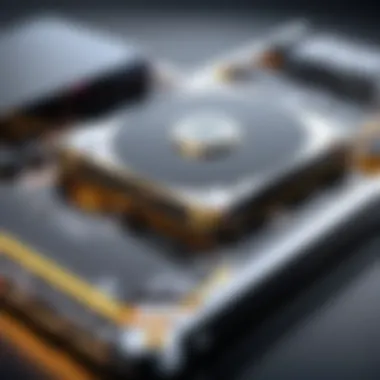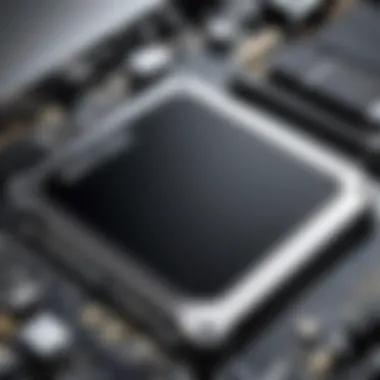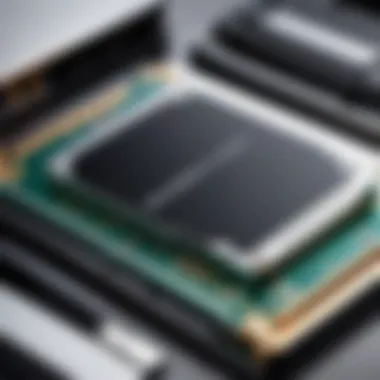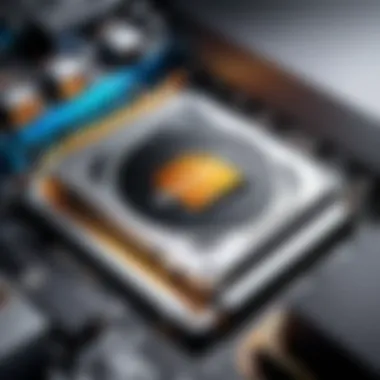Unveiling the Revolutionary Technology of Solid State Hard Disks


Product Overview
Solid State Hard Disks, abbreviated as SSDs, represent the pinnacle of storage technology in the digital era. Renowned for their exceptional speed, reliability, and efficiency, SSDs have revolutionized the realm of computer hardware. Unlike traditional hard drives that rely on spinning disks, SSDs utilize flash memory, eliminating moving parts and ensuring faster data access and transfer speeds. The key specifications of SSDs include storage capacities ranging from 128GB to a staggering 4TB, depending on the brand and model. As for pricing, SSDs are available at varying price points based on storage capacity and brand reputation, with premium models commanding higher price tags.
Performance Comparison
One of the most compelling aspects of SSDs is their unparalleled performance compared to traditional hard drives. Benchmark tests consistently demonstrate the superior speed and efficiency of SSDs in data read and write operations. SSDs boast significantly faster boot times, software loading speeds, and overall system responsiveness, making them a preferred choice for tech enthusiasts, gamers, and IT professionals seeking optimal performance from their devices. When compared side by side with HDDs, SSDs outshine in every performance metric, offering a seamless and snappy user experience.
Features and Technology
Pioneering unique features and cutting-edge technology, SSDs have redefined storage solutions in the digital landscape. SSDs are designed with advanced error-checking mechanisms to ensure data integrity and reliability. Additionally, technological advancements like TRIM support and wear leveling algorithms enhance SSD longevity and sustained performance over time. Furthermore, SSDs are compatible with various devices, including laptops, desktops, gaming consoles, and even external storage solutions, making them a versatile storage option for a wide range of users.
Pros and Cons
The strengths of SSDs lie in their exceptional speed, reliability, and durability, providing users with a seamless computing experience. SSDs excel in rapid data access, reducing software loading times, and enhancing overall system performance. However, one area for improvement in SSD technology is the cost per gigabyte, as SSDs tend to be more expensive than traditional hard drives on a per-unit storage basis. Despite the higher cost, the performance benefits and reliability of SSDs often justify the investment for users prioritizing speed and efficiency in their computing activities.
Value for Money
When evaluating the value proposition of SSDs, it's essential to consider their cost-effectiveness in the long run. While SSDs may entail a higher initial investment, their long-term benefits in terms of improved system performance, faster boot times, and enhanced data security make them a worthwhile investment for users seeking top-tier storage solutions. Comparing SSDs with similar products reveals that while SSDs may have a higher upfront cost, the overall value and efficiency they offer justify the price tag, positioning them as a premium storage choice for discerning consumers.
Introduction
Solid State Hard Disks have emerged as a transformative technology in the world of computer hardware. These innovative storage devices leverage cutting-edge technology to deliver unparalleled speed, reliability, and performance. In this article, we delve deep into the inner workings of SSDs, exploring their evolution in the storage technology landscape and highlighting the key components that make them a superior choice over traditional hard drives.
Understanding Solid State Hard Disks
Evolution of Storage Technology
The Evolution of Storage Technology has played a crucial role in shaping the landscape of data storage. With the advent of SSDs, there has been a significant shift from traditional hard drives to flash-based storage solutions. The key characteristic of Evolution of Storage Technology lies in its ability to deliver faster access times and improved efficiency. This evolution offers a more reliable and durable storage option, enhancing overall system performance.
Key Components of SSDs
SSDs comprise key components that set them apart from traditional hard drives. The architecture of SSDs includes NAND flash memory, controllers, and DRAM cache. These components work in harmony to boost storage performance, speed, and endurance. The unique feature of SSDs lies in their ability to store data electronically, eliminating the need for moving parts found in traditional hard drives, which results in enhanced reliability and speed.
Advantages Over Traditional Hard Drives
Speed and Performance
One of the standout advantages of SSDs over traditional hard drives is their exceptional speed and performance. SSDs facilitate faster data access and transfer speeds, significantly reducing loading times and improving system responsiveness. This boost in speed is advantageous for tasks requiring intensive readwrite operations, making SSDs a preferred choice for those seeking efficient storage solutions.


Durability and Reliability
SSDs excel in terms of durability and reliability compared to traditional hard drives. Their solid-state design makes them more resistant to physical shocks and damage, ensuring data integrity even in case of rough handling. The absence of mechanical components in SSDs enhances their longevity and operational stability, making them a dependable choice for data storage.
Energy Efficiency
Another notable advantage of SSDs is their energy efficiency. SSDs consume less power during operation compared to traditional hard drives, leading to lower energy costs and reduced environmental impact. This energy-efficient attribute not only contributes to sustainable computing practices but also enhances battery life in laptops and portable devices.
Impact on Computer Hardware Industry
Shift in Consumer Preferences
The widespread adoption of SSDs signifies a significant shift in consumer preferences within the computer hardware industry. Consumers are increasingly recognizing the superior performance and reliability offered by SSDs, steering away from conventional hard drives. This shift reflects a growing demand for quicker and more efficient storage solutions that align with modern computing requirements.
Technological Advancements
Technological advancements in SSDs have propelled innovation in the computer hardware industry. Continuous improvements in SSD technology, such as higher storage capacities and enhanced readwrite speeds, have revolutionized data storage capabilities. These advancements are driving the development of more advanced and efficient storage solutions, shaping the future of computing technology.
Technical Insights
Solid State Hard Disks have revolutionized storage technology, offering unparalleled speed, durability, and performance. Understanding the intricacies of these devices is crucial for maximizing their benefits. In this section, we delve deep into Technical Insights, exploring key components that drive the functionality and efficiency of SSDs. By comprehensively examining NAND Flash Memory, Controller, DRAM Cache, Wear Leveling, and TRIM, we unravel the inner workings of solid-state storage, shedding light on its impact on the digital landscape.
NAND Flash Memory
Architecture and Operation
NAND Flash Memory plays a pivotal role in the operation of SSDs, with its unique architecture enabling swift data access and storage. Its ability to retain data even without power makes it a popular choice for high-speed storage solutions. The NAND Flash Memory's architecture allows for efficient data retrieval and storage, enhancing the overall performance of solid-state drives. While its write speeds might be slower compared to read speeds, the durability and speed of NAND Flash Memory make it an ideal component for SSD technology.
Types of NAND Flash
Different types of NAND Flash, such as SLC, MLC, TLC, and QLC, offer varying levels of cost-effectiveness and storage capacities. Each type presents distinct advantages and disadvantages in terms of speed, durability, and cost. SLC provides top-notch performance but comes at a higher cost, while QLC offers larger storage capacities at a more affordable price, albeit with lower endurance. Understanding the characteristics of each NAND Flash type is essential for selecting the most suitable storage solution based on specific needs.
Controller
Functionality and Importance
The Controller serves as the brain of an SSD, managing data operations and ensuring optimal performance. Its ability to distribute data across memory cells efficiently enhances read and write speeds. The Controller's importance lies in its role in regulating data flow and maintaining data integrity. By understanding the functionality of the Controller, users can optimize their SSDs for enhanced performance and longevity.
Role in Data Management
The Controller's crucial role in data management includes error correction, bad block mapping, and wear leveling. Its capability to handle these tasks seamlessly contributes to the reliability and efficiency of solid-state drives. By overseeing data storage and retrieval processes, the Controller plays a vital part in maintaining the integrity of stored data and maximizing the lifespan of SSDs.


DRAM Cache
Enhancing Read and Write Speeds
DRAM Cache acts as a temporary storage buffer, accelerating data transfer speeds and improving overall performance. By caching frequently accessed data, DRAM Cache reduces access latency, significantly enhancing read and write operations. Its function in storing data temporarily before writing it to the drive contributes to the quick response times and smooth functioning of SSDs.
Temporary Data Storage
The utilization of DRAM Cache for temporary data storage ensures efficient data processing and quick access to frequently used information. By storing data in high-speed volatile memory, DRAM Cache optimizes read and write operations, resulting in superior system responsiveness. However, the volatility of DRAM necessitates constant power supply to prevent data loss, highlighting the importance of backup power solutions in SSD setups.
Wear Leveling and TRIM
Maintaining Longevity
Wear Leveling is a critical feature that evenly distributes write cycles across memory cells, preventing excessive wear on specific areas of the drive. By balancing data writes, Wear Leveling extends the lifespan of SSDs and maintains optimal performance over time. This functionality is essential for prolonging the durability and useable life of solid-state drives, making them a reliable storage solution.
Improving Performance
TRIM technology plays a key role in enhancing SSD performance by proactively clearing invalid data blocks and optimizing write processes. By erasing unnecessary data blocks and preparing available space for new data, TRIM reduces write amplification and improves overall drive efficiency. This process ensures consistent performance and preserves the longevity of SSDs, contributing to their reliability and sustained speed.
Performance Benchmarking
Performance benchmarking plays a crucial role in uncovering the true capabilities and efficiencies of solid-state hard disks. By evaluating sequential and random readwrite speeds, industry professionals and enthusiasts can gain valuable insights into the performance metrics of SSDs compared to traditional hard drives. This section aims to dissect the components that define the benchmarking process and its significance in assessing storage drive performance accurately.
Sequential and Random ReadWrite Speeds
Measuring Speed Performance
In the realm of measuring speed performance, the focus lies on gauging the efficiency of data transfer processes within solid-state hard disks. This measure plays a vital role in overall system responsiveness, highlighting the capability of an SSD to handle data-intensive tasks effectively. The precision and consistency offered by these benchmarks underscore their importance in determining the suitability of SSDs for various computing requirements. With a meticulous examination of how measuring speed performance influences the user experience, it becomes clear why this metric is a staple in evaluating the performance prowess of solid-state hard disks.
Real-world Applications
Delving into real-world applications allows for a pragmatic understanding of how the measured speeds translate into enhanced user experiences across different usage scenarios. By showcasing the practical implications of speed benchmarks in tasks like content creation, gaming, and data processing, readers can grasp the tangible benefits brought forth by high-performance solid-state hard disks. Evaluating how real-world applications align with measured benchmarks provides a holistic perspective on how these devices integrate seamlessly into diverse computing environments, directing the discourse towards practical utility and performance optimization.
IOPS and Latency
Enhancing Responsiveness
The intricacies of enhancing responsiveness elucidate the intricate relationship between inputoutput operations per second (IOPS) and latency in solid-state hard disks. This section will explore how these metrics impact system agility, reflecting on the direct correlation between responsiveness and user satisfaction. By dissecting the nuances of IOPS and latency, readers can appreciate the nuances of speed optimization in SSDs, thereby gaining insights into the dynamic nature of storage performance management.


Impact on Workloads
Analyzing the impact of SSD responsiveness on varied workloads sheds light on the adaptability and operational efficiency of solid-state drives across different task categories. Whether handling intense gaming sessions or data-intensive professional tasks, understanding how workload requirements influence performance expectations is imperative. By critically examining how SSDs navigate workload challenges, this section underscores the pivotal role of responsiveness in determining the fluidity and reliability of system operations, propelling the narrative towards tailored performance benchmarks that resonate with contingency requirements.
Endurance and Lifespan
Factors Affecting Longevity
Diving deep into the factors affecting the longevity of solid-state hard disks unveils the intricate variables that dictate the operational lifespan of these storage solutions. From temperature regulation to workload distribution, an array of factors can influence the durability and sustained performance levels of SSDs. By navigating through the key characteristics that contribute to prolonged longevity, readers will gain a nuanced understanding of the environmental and usage aspects that impact the overall health of solid-state drives.
Overprovisioning for Endurance
Examining the concept of overprovisioning for endurance provides insights into the strategic allocation of excess storage capacity to maintain optimal performance levels over time. This practice enhances the wear leveling mechanisms of SSDs, safeguarding against premature degradation and ensuring long-term operational stability. By unpacking the advantages and potential drawbacks of overprovisioning, this segment offers a roadmap to extending the endurance and reliability of solid-state hard disks, steering the conversation towards proactive maintenance strategies and future-proofing considerations.
Future Trends and Innovations
In the rapidly evolving landscape of computer hardware, the section on future trends and innovations holds paramount significance. As technology progresses at an unprecedented pace, staying abreast of the latest advancements is crucial for industry professionals and enthusiasts alike. This segment sheds light on the emerging developments poised to reshape the storage industry's future trajectory, serving as a compass for navigating the dynamic realm of solid-state hard disks. From enhanced storage capacities to cutting-edge technologies such as QLC and PLC, this section delves deep into the forefront of innovation, offering a glimpse into what lies ahead in the ever-evolving world of SSDs.
QLC and PLC Technologies
Enhanced Storage Capacities
Exploring the domain of enhanced storage capacities unravels a fascinating realm where the boundaries of traditional storage metrics are redefined. With advancements in Quad-Level Cell (QLC) and Penta-Level Cell (PLC) technologies, the storage landscape witnesses a quantum leap in the amount of data that can be stored in a single SSD unit. This translates into higher capacities that enable users to house vast amounts of data in a compact form factor, revolutionizing storage convenience and accessibility. The key characteristic of enhanced storage capacities lies in their ability to cater to the escalating demands for data storage without compromising on speed or performance. Their unique feature lies in delivering unparalleled storage densities, making them a favored choice for data-intensive applications in both professional and personal computing spheres.
Challenges and Developments
As with any technological innovation, the realm of QLC and PLC technologies poses its unique set of challenges and opportunities for development. Navigating the intricacies of achieving higher storage capacities while maintaining optimal performance levels requires innovative solutions to mitigate potential bottlenecks. Challenges such as data integrity, endurance, and error rates punctuate the developmental landscape, urging industry stakeholders to continually enhance their design and manufacturing processes. However, these challenges serve as catalysts for innovation, propelling advancements that push the boundaries of storage capabilities. By addressing these challenges head-on, industry players pave the way for groundbreaking developments that redefine the benchmarks of storage efficiency and effectiveness.
NVMe and PCIe 4. Interface
Breaking Performance Barriers
The integration of Non-Volatile Memory Express (NVMe) and Peripheral Component Interconnect Express (PCIe) 4.0 Interface heralds a new era of performance optimization in the SSD domain. By leveraging the exceptional data transfer speeds and low latency offered by NVMe technology, coupled with the enhanced bandwidth capabilities of PCIe 4.0, SSDs can break through traditional performance barriers. The key characteristic of this fusion lies in maximizing data throughput and minimizing inputoutput wait times, resulting in lightning-fast response times and seamless multitasking experiences for users. The unique feature of breaking performance barriers lies in unleashing the full potential of SSDs, allowing them to unleash unrivaled speeds and efficiencies that elevate computing experiences to unprecedented levels.
Optimizing Data Transfer
Optimizing data transfer goes beyond mere speed improvements; it encapsulates a holistic approach to enhancing the overall data handling experience. By prioritizing data integrity, security, and efficiency, the NVMe and PCIe 4.0 Interface synergistically optimize data transfer processes, ensuring seamless communication between components and peripherals. The key characteristic of this optimization lies in streamlining data flow and minimizing latency, thereby eliminating potential data bottlenecks and maximizing system responsiveness. The unique benefits of optimizing data transfer manifest in improved system reliability, enhanced user experiences, and a future-proof infrastructure that caters to evolving data demands.
Emerging 3D NAND Architectures
Vertical Integration for Efficiency
The advent of vertical integration in 3D NAND architectures marks a paradigm shift in storage efficiency and scalability. By stacking memory cells vertically to increase storage density, SSD manufacturers optimize space utilization and operational efficiency, paving the way for compact yet powerful storage solutions. The key characteristic of vertical integration lies in maximizing storage capacity within limited physical footprints, offering unprecedented levels of data storage in increasingly compact form factors. The unique feature of this approach lies in its ability to enhance efficiency, reduce production costs, and improve overall performance, making it an attractive choice for addressing the escalating demands for high-capacity storage solutions.
Scaling Storage Solutions
Navigating the landscape of scaling storage solutions unveils a world where adaptability and scalability reign supreme. By devising innovative approaches to expand storage capacities without compromising performance, SSD manufacturers cater to the diverse needs of consumers and enterprises seeking robust storage solutions. The key characteristic of scaling storage solutions lies in their flexible scalability, allowing users to expand storage capacities as needed without sacrificing speed or efficiency. The unique feature of this scalability lies in its capability to future-proof storage infrastructures, accommodating burgeoning data requirements and technological advancements seamlessly. This strategic approach ensures that storage solutions evolve in tandem with user needs, offering a sustainable and versatile solution that can adapt to changing demands and technological landscapes.







